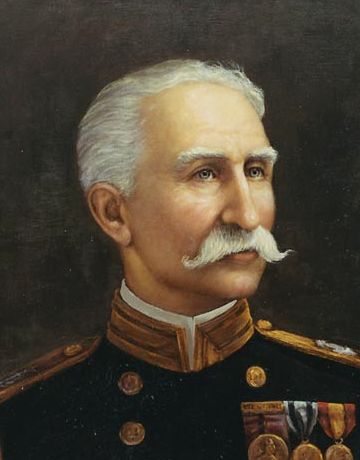
From Naval History & Heritage Command photo NH 77172 KN.
Rear Admiral Bradley A. Fiske, USN by Orlando Lagman.
His early service years included duty as an officer in the steam sloops-of-war Pensacola and Plymouth, both on the Pacific Station, and in the paddle steamer Powhatan in the Atlantic. He also received instruction in the then-young field of torpedo warfare.
He was promoted to master in 1881 and lieutenant in 1887. During much of that decade he had training ship duty in USS Saratoga and USS Minnesota, served in the South Atlantic Squadron on the steam sloop Brooklyn and was twice assigned to the Bureau of Ordnance in Washington, D.C.
Fiske was recognized as one of the Navy’s most technically astute officers. In 1886–1888, he supervised the installation of ordnance in USS Atlanta, one of the Navy’s first modern steel warships. In 1888–1890, he was involved in the trials of USS Vesuvius, whose large caliber compressed-air guns were then considered a promising experiment, and was in charge of installing electric lighting in the new cruiser Philadelphia.
During the rest of the 1890s, Lieutenant Fiske was mainly employed at the Bureau of Ordnance and at sea, where he was an officer in the cruiser San Francisco and the gunboats Yorktown and Petrel. While serving in the latter, he took part in the Battle of Manila Bay on 1 May 1898.
Following the Spanish-American War, Fiske continued his service in Philippine waters on board the monitor Monadnock. He advanced rapidly in rank: to lieutenant commander in 1899, commander in 1903 and captain in 1907. He held many responsible positions on shore and at sea, serving as an Inspector of Ordnance, Executive Officer of USS Yorktown and the battleship Massachusetts and Commanding Officer of the monitor Arkansas and cruisers Minneapolis and Tennessee. He also had recruiting duty, served as Captain of the Yard at the Philadelphia Navy Yard, attended the Naval War College and was a member of the Navy’s General Board and the Army-Navy Joint Board.
In August 1911, Fiske was promoted to Rear Admiral and subsequently commanded three different divisions of the Atlantic Fleet. He served as the Secretary of the Navy’s Aide for Inspections.
In February 1913, he was appointed Aide for Operations, a post that later became that of Chief of Naval Operations. As Aide for Operations, Fiske forcefully advocated the creation of a Naval general staff and the elevation of the Nation’s preparedness for war.
Rear Admiral Fiske retired in June 1916 following a year at the Naval War College. His professional activities continued into the mid-1920s, however, including a term as President of the US Naval Institute and several sessions of temporary duty with the Navy Department.
During his long career, Rear Admiral Fiske invented many electrical and mechanical devices, with both Naval and civilian uses, and wrote extensively on technical and professional issues.
Rear Admiral Fiske died at New York City on 6 April 1942 at the age of 87.
Source: Arlington National Cemetery.